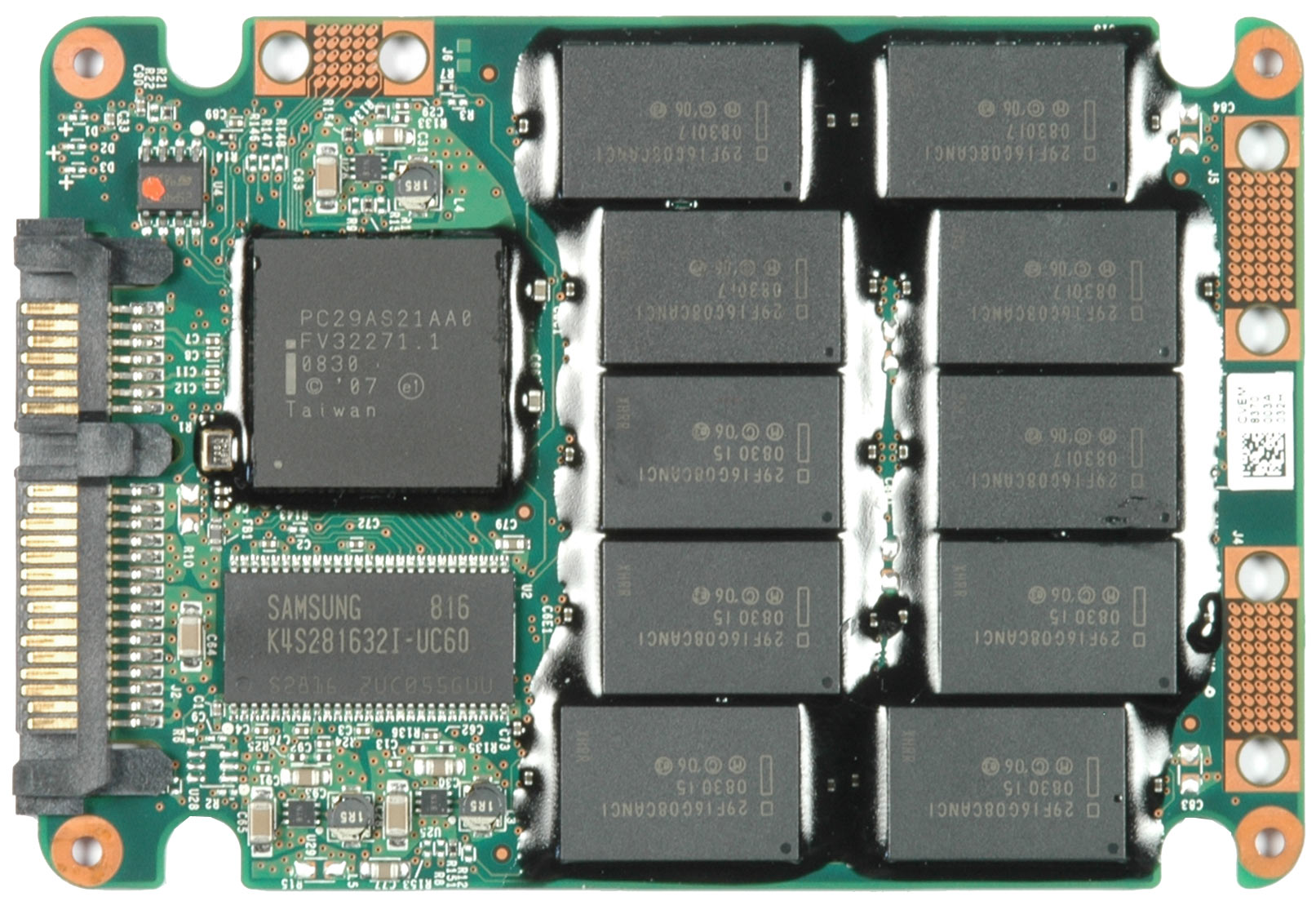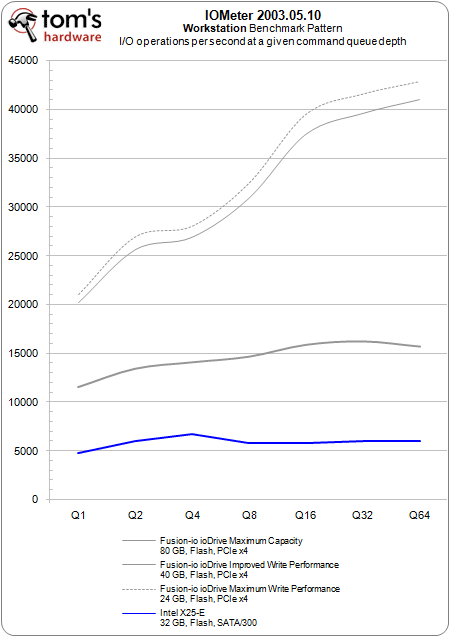Intel’s X25-E Versus The Fusion-io ioDrive
Flash Storage Taking Off
Progress in the storage segment has probably been more noticeable than in other market segments recently, except perhaps graphics. Faster processors are mainly noticeable if you have the applications able to take advantage of them, and advances on the platform side have been slight as well. But accelerated hard drives and storage products make a noticeable difference. Client PCs, such as desktops and notebooks, boot their operating systems and applications faster thanks to increased throughput, and servers can process more I/O operations per second with faster storage as well.
Fusion-io ioDrive Versus Intel X25-E SSD
The recent developments in enterprise-class storage products are mind-boggling. We decided to look at the two most innovative products: Intel’s X25-E flash SSD for servers, and the ioDrive by Fusion-io. Both are based on flash memory and promise stellar performance compared to any type of mechanical hard drive, or even RAID arrays composed of them. Let’s find out which is the best server drive.
Check prices for Intel's X25-E 32 GB SSD
Fusion ioDrive Details
The ioDrive is not a typical drive, as it is based on flash memory and connects to the host PC via x4 PCI Express rather than Serial Attached SCSI (SAS) or Serial ATA (SATA). Since both SAS and SATA provide only 300 MB/s throughput (600 MB/s by the end of this year), picking a more direct way of connecting to the host makes sense for achieving higher throughput.
Fusion-io has 80 GB, 160 GB, and 320 GB versions, so they offer more capacity than average server SSDs (which are still limited to 32/64 GB). Fusion uses multi-level cell (MLC) flash for its highest capacity version, but faster single-level cell (SLC) flash memory for the 80 and 160 GB models.
The low-profile ioDrive can be installed into regular PCs or into 2U servers with an available x4 or wider PCI Express slot. You cannot yet boot from it, though, since it does not use a conventional mass storage interface. Clearly, this product isn’t really helpful on desktop PCs, but it impresses in servers, where a fast storage product and a high number of I/O operations per second are essential.
Get Tom's Hardware's best news and in-depth reviews, straight to your inbox.
Have a look at our ioDrive review for more details.
Check prices for Intel's X25-E 32 GB SSD
FusionIO Features And Management
While any SATA or SAS drive can be attached directly without further ado, the ioDrive requires drivers. There are Linux and 64-bit Windows drivers available, but Fusion-io does not (yet) provide 32-bit drivers.
You have to use a utility called the IoManager to set your desired performance mode. You can either use the full capacity of 80 GB in the case of our test sample (Maximum Capacity mode), or switch to one of the performance enhancing modes. Improved Write Performance mode utilizes a sort of write distribution algorithm to accelerate writes, but it limits capacity to 40 GB. Finally there is a Maximum Write Performance mode, which further reduces capacity to 24 GB, while giving you even more write performance benefits. These benefits mostly affect I/O performance, but write throughput also gains somewhat—if you’re willing to give up the capacity, of course.
Have a look at our ioDrive review for more details.
Check prices for Intel's X25-E 32 GB SSD
Intel X25-E Flash SSD
While Intel’s X25-M mainstream 2.5” flash SSD was extremely convincing, the X25-E is even better. It cannot provide more read throughput than its predecessor, and it is limited to 32/64 GB capacities until later this year, but its write transfer performance is at least twice as fast thanks to the faster SLC flash memory. The X25-M writes at less than 100 MB/s, while the X25-E reaches almost 170 MB/s. On the flip side, an X25-M is available at capacities of up to 160 GB.
The real advantages of the X25-E become obvious once you have it deal with I/O-intensive applications. It is simply much faster than any other flash SSD we have had in our storage test lab; it is capable of delivering I/O performance that puts it in a league of its own. A single X25-E flash SSD can provide the I/O performance of large and complex SAS RAID arrays based on 15,000 RPM hard drives. And it does this while consuming less than 2 watts of power, while such a RAID array will require 100 to 200 W.
The X25-E is based on a SATA/300 interface, which is the case for pretty much all flash SSDs currently available.
Check prices for Intel's X25-E 32 GB SSD
X25-E Details And Test Setup
Both sides of the circuit board are populated with SLC flash memory chips, but the top also holds Intel’s flash memory controller, including the Serial ATA interface. In addition, you can find a Samsung IC, which is used as a cache memory. As we could see on the X25-M as well as on the X25-E, the controller works extremely efficiently. Write amplification is not a major issue for the Intel drives, and performance turned out to be rather consistent when compared to other flash SSDs.
Right now, the Intel X25-E only has real competition in Korea—Memoright and Mtron are the only vendors that position their flash SSDs for servers as well. However, we found that the X25-E is superior in almost every benchmark.
Test Setup
| System Hardware | |
|---|---|
| Processor(s) | Intel Core 2 Duo E8500 (45nm, 3.16 GHz, 6MB L2 Cache) |
| Platform | Gigabyte P45T-Extreme, Rev 1.0Intel P45 Chipset, BIOS 1710 |
| RAM | 4x 1 GB DDR-1066 Crucial BL12864BA1608 |
| System Hard Drive | Seagate Barracuda 7200.980 GB, 7,200 RPM, 8 MB Cache, SATA/300 |
| Mass Storage Controller(s) | 82801JIR ICH10 RAID (ICH10R) |
| Graphics Card | ATI Radeon 3850 |
| Benchmark Software | |
|---|---|
| Performance Measurements | h2benchw 3.6 |
| I/O Performance | IOMeter 2003.05.10, Fileserver-Benchmark, Webserver-Benchmark, Database-Benchmark, Workstation-Benchmark |
| System Software And Drivers | |
|---|---|
| OS | Microsoft Windows Server Standard x64 SP1 |
| Platform Driver | Intel Chipset Installation Utility 9.0.0.1008 |
| Graphics Driver | Radeon 8.11 |
| Fusion-io Driver | Release 1.2.2.14 |
Benchmarks: Interface Throughput
We decided to only post the results of the interface bandwidth benchmark test, as nobody would go for an enterprise flash SSD to get high transfer rates. Any modern 15,000 RPM hard drive is capable of delivering between 100 and 150 MB/s read and write throughput easily, and at a fraction of the cost of these units.
Throughput reaches almost 600 MB/s in the case of the ioDrive by Fusion-io, while Intel’s X25-E reached a maximum of 223 MB/s. Keep in mind that the 80 GB ioDrive starts at a bit less than $3,000, while the Intel SSD costs only a fraction of that. Creating RAID arrays based on X25-E drives might be an attractive option.
Check prices for Intel's X25-E 32 GB SSD
Benchmarks: File Server I/O
The ioDrive reaches file server I/O performance that is roughly twice as high as the results on the Intel X25-E. However, again, don’t forget the price of the Fusion-io offering, which starts at more than three times the cost of a single X25-E.
Comparison: 15,000 RPM hard drives reach 250-350 I/O operations per second in this benchmark, while the two flash devices are roughly 20 times faster.
Check prices for Intel's X25-E 32 GB SSD
Benchmarks: Database
The database I/O benchmark results are quite interesting. Intel’s X25-E reaches 6,500 to 10,000 I/O operations per seconds at small command queue depths, but drops to a little more than 4,000 I/Os at deep command queues. The ioDrive is different. While it reaches 2.5x more performance than the X25-E at executing individual commands, it drops to a bit more than the Intel’s performance at longer command queues. Switching the ioDrive to one of the faster write modes, which results in reduced capacity, results in more than doubling I/O performance. In such a case, a RAID array of Intel X25-E SSDs could not catch up for the same cost of an ioDrive.
Comparison: 15,000 RPM hard drives reach 200-300 I/O operations per second in this benchmark. The flash based SSDs are up to 180 times faster!
Check prices for Intel's X25-E 32 GB SSD
Benchmarks: Web Server
Web Server performance is impressive in both cases, although the ioDrive is roughly three times faster than Intel’s X25-E.
Comparison: 15,000 RPM hard drives reach 250-500 I/O operations per second in this benchmark.
Check prices for Intel's X25-E 32 GB SSD
Benchmarks: Workstation
Workstation performance is roughly similar to the results in the file server benchmark. The Intel X25-E SSD is more than ten times faster than any hard drive, but the ioDrive still more than doubles the performance level. Switching to accelerated write modes again doubles to triples the Fusion-io product's performance.
Comparison: 15,000 RPM hard drives reach 200-350 I/O operations per second in this benchmark.
Check prices for Intel's X25-E 32 GB SSD
Conclusion
The fastest high-performance storage solution is the ioDrive by Fusion-io, which provides 80, 160, or 320 GB of storage capacity on a x4 PCI Express add-on card. It can be installed into any system that offers a suitable expansion slot, but you are limited to 64-bit operating systems because the product requires drivers. In addition, the ioDrive is not a conventional drive storage solution as we know them, since you cannot boot from it, and you cannot fit it into a small form factor system due to its add-on card design. Its price starts at around $3,000, and it provides the highest possible I/O performance at this price point; only RAM drives are capable of beating this—at much higher cost and smaller capacity.
However, Intel’s X25-E is not a loser. Our review revealed that it currently is the fastest standard drive for server environments. Its SATA/300 interface may not be suitable for all applications, but SAS controllers are capable of operating SATA drives as well. Capacities of the X25-E may not match those of the ioDrives or hard drives, but its capacity and performance per watt certainly do. At $500, the X25-E is affordable enough to create RAID arrays of five to six drives at the cost of an entry-level ioDrive.
Neither the ioDrive nor the X25-E flash SSD were designed to deliver maximum throughput. This can still be done better by arrays of fast 15,000 RPM hard drives.
Check prices for Intel's X25-E 32 GB SSD









